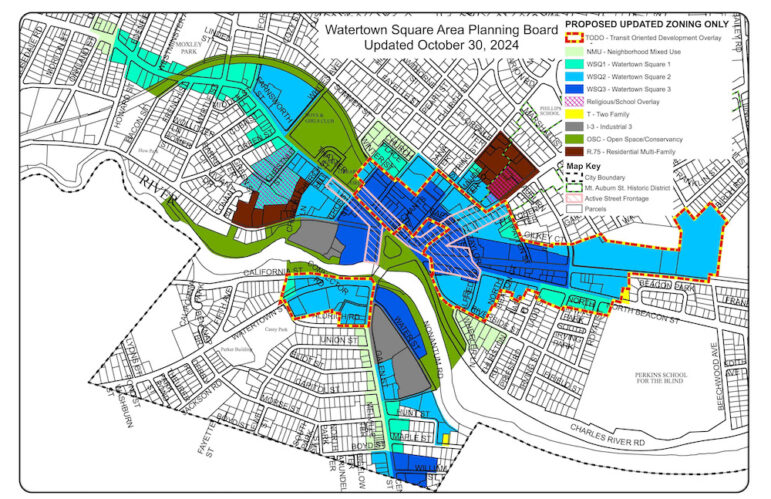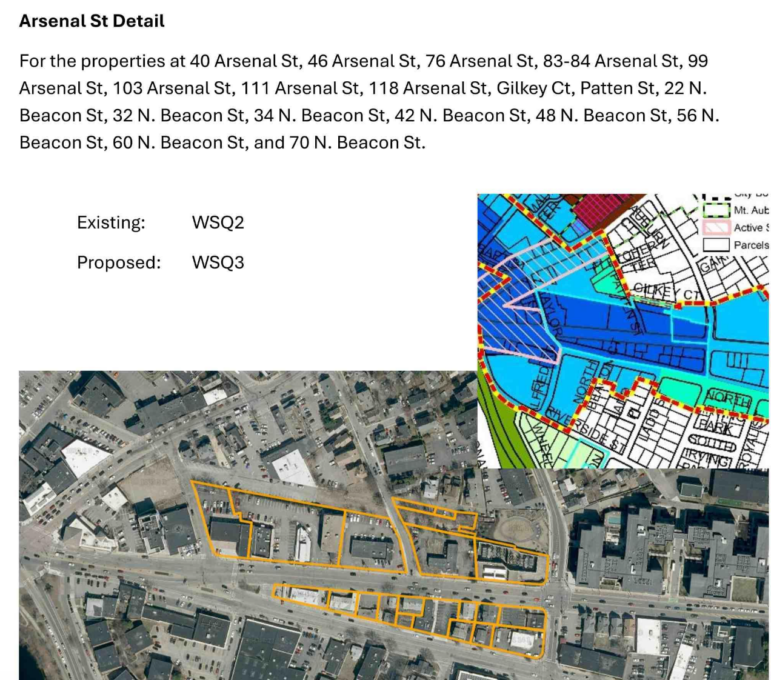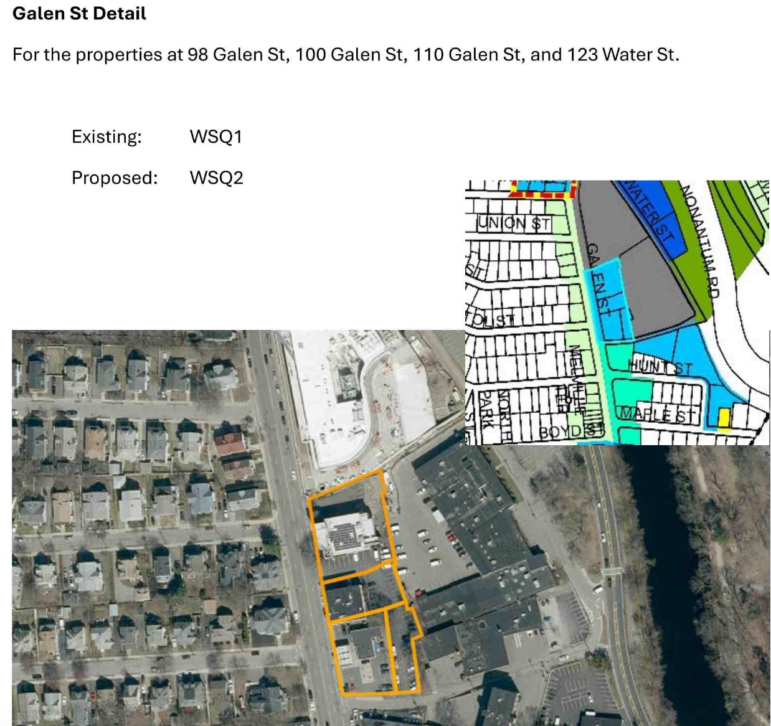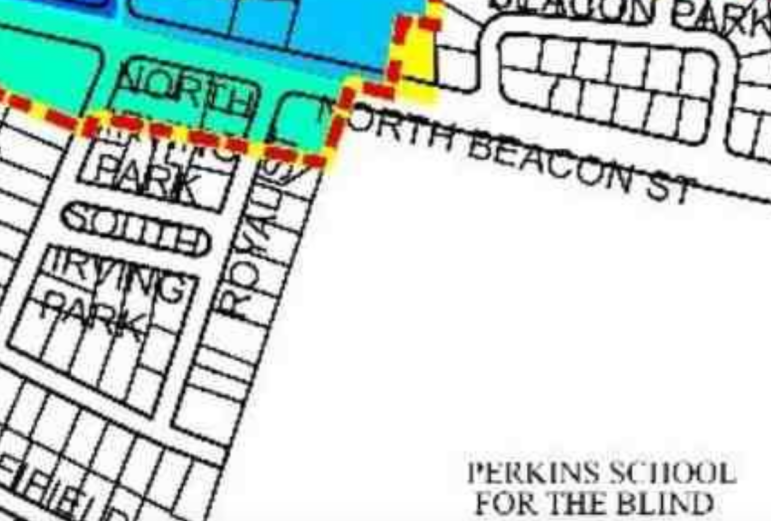
After nearly a year of planning, meetings and discussion, the Watertown Square Area Plan zoning changes have been adopted by the City Council. The updated zoning will meet the State’s housing requirements, even after trimming back some of the recommendations from the Planning Board, and the Council increased the green building requirements for new projects.
Thursday night, the Council approved the Watertown Square Zoning unanimously. They included a majority of the changes recommended by the Planning Board on Oct. 30, but Councilors also adopted several amendments.
Sustainable Building Requirements
The Planning Board recommended zoning changes sent to the City Council called for new projects in the Watertown Square Area Plan zones to be required to be built to meet LEED (Leadership in Energy and Environmental Design) Silver certifiable standards. The standards created by the U.S. Green Building Council can be met by making the buildings energy efficient and built in sustainable ways.
Assistant City Manager Steve Magoon said the proposal was to have the projects certifiable, rather than certified, because the process to get a project officially certified is costly.
City Councilor Nicole Gardner proposed changing the requirement so that they must be LEED Gold certifiable, a step above Silver.
Magoon said there could be some pushback from the State about the requirement, in part because the current Citywide requirement is LEED Silver certifiable. Because the zoning will be submitted to meet the MBTA Communities Law’s goal of building more housing, Magoon said State officials could look at the increased sustainability requirement as a way to discourage new housing developments.
Magoon added that the same thing is possible with Watertown’s requirement for affordable housing: at least 15 percent of the units. The MBTA Communities Law allows for 10 percent, but Magoon said he is confident Watertown can show 15 percent will not inhibit housing because projects have been built with the 15 percent requirement.
City Council President Mark Sideris supported the LEED Gold requirement and said that Watertown has been a leader in green building by adding solar requirements and having LEED Silver certifiable requirements for all projects in town above a certain size.
“We have established a high level. We are building a $200 million high school that is LEED Platinum, and built two elementary schools that are LEED Gold,” Sideris said. “We are not doing anything that is inconsistent with what we have been doing.”
City Manger George Proakis said that he would be willing to press the State if they do not approve the LEED Gold certifiable standard.
“I am happy to meet with the Executive Office of Housing and Livable Communities,” he said. “We have vastly exceeded the 1,701 (by right housing units) commitment on housing.”
Councilor Caroline Bays brought up the possibility of allowing an extra floor of housing if the developer meets the LEED Platinum certifiable standard. She did not propose and amendment because the City will soon be examining the zoning requirements for the entire City and it could be discussed at that time.
The Council approved the amendment 9-0.
Zoning Map Changes
A few of the Planning Board recommended changes to the original Zoning proposal were amended by the City Council, including areas along Galen Street, North Beacon Street, and Arsenal Street.
Councilor Lisa Feltner, who represents a large section of the area in the plan, said she did not like the idea of having the most dense zoning for the area between North Beacon Street and Arsenal Street west of Irving Street. The Watertown Square 3 (WSQ3) zoning allows for up to six stories, with the top story stepped back so it does not have as much visual impact on from the street level. She had the same concern about the parcels on the north side of Arsenal Street between Taylor and Irving streets.

Nearby streets are residential, with single- and two-family homes, and she said having buildings up to six stories tall would be a big impact, possibly casting shadows on homes. Feltner proposed reverting to the original proposal of WSQ2 zoning for those areas, which would allow up to 5 story buildings and would be consistent with the other properties on the north side of Arsenal Street. The Council voted 9-0 to approve the amendment.
For similar reasons, Feltner proposed “downzoning” a set of parcels on the east side of Galen Street that had been proposed to be made WSQ2. She argued that the rest of that side of the street was zones as WSQ1, which allows up to four stories and that the original proposal from the Staff had that zoning.

Bays said that the parcels are next to the recently built 66 Galen St. development, which is five stories tall, and the properties are not as close to residential properties as farther south on Galen Street. Gardner said the properties also sit right near the MBTA’s Watertown Yard bus hub.
Sideris said he does not want Galen Street to be “canyonized” with tall buildings on both sides.
The Council approved the change by a vote of 6-3.
A handful of properties on the south side of North Beacon Street, from Irving Street to the Perkins School for the Blind property line, were proposed to be zoned for WSQ1 by right, which means the projects would not have to get a special permit from City boards. Feltner made a motion to change the plan so that the building height would be allowed but would be required to go before the Planning and Zoning Boards to get a special permit. The amendment was approved 9-0.

Alternate Ways to Meet Open Space Requirements
The new zoning includes requirements for projects to include publicly accessible open space. Magoon said that for some of the projects in Square the open space would not be very big. As an alternative, the City staff proposed allowing a contribution of money or land in another location to meet the requirement.
One example of such a contribution is the park across Irving Street from the Elan Union Market Apartments, which the developer created as part of the project. Some councilors asked whether there are enough parcels in Watertown to meet the requirement. Magoon said a financial contribution could go be combined with contributions from other project to create or purchase open space in the area. One opportunity, Magoon said, is in the proposed redevelopment of the municipal parking lots behind CVS and the Watertown Library.
Councilors wanted to make sure that the amount of land or the financial contribution would match the amount that a development is required to provide. They added the language that the in-lieu contribution be “commensurate in size or value” to that of the open space that would be required for the project. The amendment was approved 9-0.
Unbundled Parking
The new zoning allows for parking spaces to be unbundled from units in residential projects. That allows fewer parking spaces, Magoon said, and residents can save money by not having a parking spot.
Multiple Councilors said they worry about people parking in neighborhoods as a way to avoid paying for parking or if there are not enough parking spaces.
Magoon said that in cases where residents have complained of cars from a development parking in the neighborhood, City officials have worked with the management of those developments to have them monitor where cars are parking and warn residents that they should not be parking on the street. He addd that if people continued to do so after being warned, the enforcement mechanisms are limited.
“We could work with the Police Department but we would try not to make that the enforcement mechanism,” Magoon said.
Household Definition
A change in the Zoning Ordinance coming out of the Watertown Square Area Plan Zoning is the definition of a household. Previously, a housing unit could have up to four non-related people or up to 10 family members. The new definition combines family and households, so up to 10 people can live in a home, if there is capacity.
Multiple Councilors, as well as former Councilor Angeline Kounelis, said that they have seen or heard of places in Watertown where many non-related people live in a single unit to create a boarding house of sorts. They wondered how the City would be able to make sure this situation does not occur under the new household definition.
Magoon said that typically when the Code Enforcement Officer inspects a home suspected of having too many residents he looks at whether there is more than one kitchen. There are also requirements for the amount of square footage and other items in the sanitary code that can be enforced, Magoon said.
Kounelis said that there may be only one kitchen, but people may have a microwave in their room to allow them to eat.
Resident Elodia Thomas said she has a property she rents that would be allowed to have up to nine tenants under the new definition. She does not want to rent to that many people, but also does not want to be sued for housing discrimination.
See the details of the Planning Board’s recommendations by clicking here. See the documents for the Watertown Square Zoning by clicking here.
Reminder that comments must be signed with your full name.